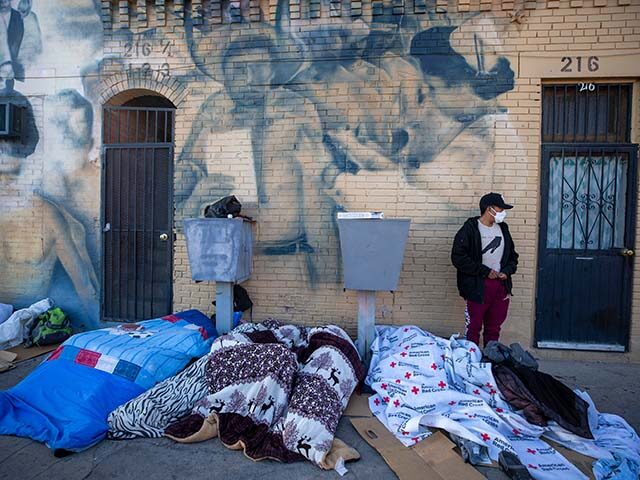President Joe Biden’s flood of poor migrants is overflowing taxpayer-funded shelters and streaming into city streets and parks, causing alarm among voters, families, and city officials alike.
“It’s a question on everybody’s mind,” said New York-based Dave Giffen, the executive director of the activist non-governmental organization, Coalition for the Homeless. “There’s unquestionably more people sleeping in public spaces now.”
As the number of migrants continues to grow in the Big Apple, authorities are beginning to become concerned over the number of border crossers who are choosing to live outside in tents instead of going into the city’s shelter system.
One such camp has sprung up in Randall’s Island where literally hundreds of tents are routinely pitched by illegal aliens. Another outdoor camp has sprung up under a highway overpass in Brooklyn. But there are many more such encampments, the New York Times recently reported.
With the city already struggling to house some 65,000 migrants, a major factor spurring migrants to camp outside in tents is that they feel unsafe in the massive shelters arranged by city officials. Many migrants in these open-air encampments told the paper that there is no order or safety inside the buildings the city has refashioned into shelters and gangs, drugs, unruly behavior, and human trafficking is rife inside the shelters the city runs. Ultimately, they told the Times they feel safer outside in tents.
Actual citizens have complained about these conditions for months. And not just in New York, but in cities including Denver, Chicago and Boston, as well. Indeed, nearly everywhere there are migrant shelters, rising crime rates follow.
As to New York City, officials made a change to the long-standing “right to shelter” rules by placing a 60-day limit to the requirement to give shelter to homeless people.
However, despite the legalese of the updated rules, few have been evicted from city shelters because officials keep granting extensions to every migrant that applies for one. And many who actually were evicted simply re-applied at other shelters where their time limit clock starts ticking all over again.
But it is the number who are now opting to sleep in the streets and avoid the shelters altogether that is worrying city officials.
“That’s not OK,” said Anne Williams-Isom, the deputy mayor leading New York’s migrant response. “We’re not trying to be heavy-handed, but if you’ve had your time, you’ve had your case management, and you have to leave, you have to really move on.”
But instead of moving on, many are just moving outdoors.
“Unease over the violence has led some migrants to seek safety outside the shelter system,” the Times reported last Friday. “Migrants sleep on blankets, under tarps that they stretch over tree branches, or crammed into a colorful mosaic of camping tents some have ordered off Amazon. They pool their money to buy eggs, bread and meat to cook breakfast and stews that they sell or share among themselves.”
In some locations — such as Randall’s Island — the tent dwellers rush to tear down their encampments each morning to avoid security and police sweeps which are sporadically implemented to stop tent cities from forming. But in other locations they seem to be settling in for the long term.
New York is not the only deep blue state trying to put more limits on migrants. Massachusetts Gov. Maura Healey has also begun moving toward trying to put limits on the Bay State’s so-called “right to shelter” laws by shifting waitlists to prioritize actual residents and U.S. military veterans who are homeless and putting those folks ahead of migrants. Massachusetts has been suffering from criticism for several years now by putting migrants ahead of veterans and citizens who are homeless.
With costs quickly closing in on a billion dollars, the state’s shelter system has become a bottomless pit for tax dollars in Massachusetts.
“We have been saying for months now that the rapid growth of our Emergency Assistance shelter system is not sustainable,” Healey said, according to WBUR-TV. “Massachusetts is out of shelter space, and we simply cannot afford the current size of this system.”
According to the Center for Immigration Studies, the population of illegal immigrants in Massachusetts totals to an unsustainable 355,000 illegals.
The people of Massachusetts have already spent $1 billion on the state’s shelter system, but that cost will soar to another $1.8 billion by 2026, according to the Center for Boston Herald.
But the costs are actually far, far higher because this $1 billion is only the cost of the housing and does not include the costs of feeding, clothing, educating, and giving free medical and legal aid to those in the shelter system. Nor does it include other social services such as food stamps, Medicaid and the costs of other such programs.
The costs piling up in other areas are rarely included in reviews of how much illegal aliens cost the state. For instance, the cost to the Bay State’s food stamp program alone could ring in at $4.6 million by 2026. Then there is the rarely noted costs of incarcerating illegals arrested for crimes which now tops $27 million a year.
The situation is echoed all across the country in Illinois, California, Colorado, and every other city being swamped by Joe Biden and Kamala Harris’s wave after wave of illegal migrants.
Follow Warner Todd Huston on Facebook at: facebook.com/Warner.Todd.Huston, or Truth Social @WarnerToddHuston

COMMENTS
Please let us know if you're having issues with commenting.